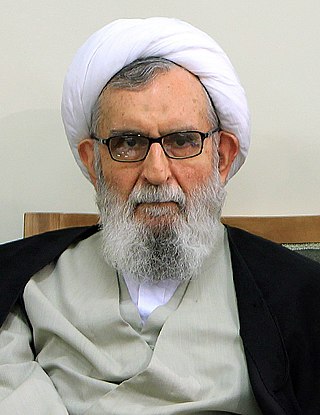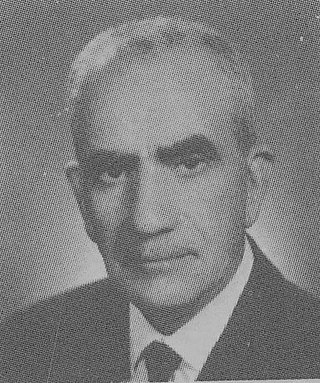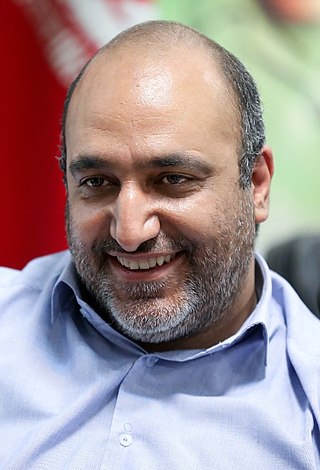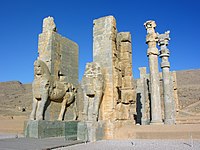
Mashhad is the second-most-populous city in Iran, located in the relatively remote north-east of the country about 900 kilometres from Tehran. In the Central District of Mashhad County, it serves as the capital of Razavi Khorasan Province, the county, and the district. It has a population of about 3,400,000, which includes the areas of Mashhad Taman and Torqabeh.

Tabas is a city in the Central District of Tabas County, South Khorasan province, Iran, serving as capital of both the county and the district.

Razavi Khorasan Province is one of the 31 provinces of Iran, located in northeastern Iran. Its capital is the city of Mashhad. Central Khorasan is one of the three provinces that were created after the division of Khorasan Province in 2004. In 2014, it was placed in Region 5 with Mashhad as the location of the region's secretariat.

The Central Library of Astan Quds Razavi is a large library in Mashad, Iran. Established before 1457, it holds over 1.1 million volumes. It is an international center for Islamic research, containing numerous manuscripts and rare works of antiquity of Islamic history.

Goharshad Mosque is a grand congregational mosque built during the Timurid period in Mashhad, Razavi Khorasan Province, Iran, which now serves as one of the prayer halls within the Imam Reza shrine complex.

Abbas Vaez Tabasi was an influential Iranian cleric who held memberships at different institutions. He was Grand Imam and Chairman of the Astan Quds Razavi board from 1979 until his death in 2016.

Astan Quds Razavi is a bonyad based at Mashhad, Iran. It is the administrative organization which manages the Imam Reza shrine and various institutions which belong to the organization.

The Imam Reza shrine, located in Mashhad, Iran, is an Islamic shrine containing the remains of Ali al-Rida, the eighth Imam of Shia Islam. It is the largest mosque in the world by area. Also contained within the complex are the Goharshad Mosque, a museum, a library, four seminaries, a cemetery, the Razavi University of Islamic Sciences, and other buildings.

Shahr Khodro Football Club, previously known as Padideh, is an Iranian football club based in Mashhad, Razavi Khorasan, that competes in the Persian Gulf Pro League. The club was founded in 2013 and was known as Padideh Khorasan Football Club between 2013 and 2019, and between March and August 2021.

Grand Ayatollah Sayyed Abdullah Al-Musawi Al-Shirazi was a Grand Ayatollah of Twelver Shi'a Islam.
Mashhad Rizeh is a city in, and the capital of, Miyan Velayat District of Taybad County, Razavi Khorasan province, Iran. It also serves as the administrative center for Dasht-e Taybad Rural District.

The Imam Reza Stadium is an all-seated football stadium located in Mashhad, Iran. The stadium has a seating capacity of 27,700 and is the sixth biggest stadium in Iran. It hosts some matches of the Iran national football team. The stadium completed in January 2017 and was opened on 14 March 2017 on the day of Chaharshanbe Suri.
Mehdi Azizian is an Iranian businessman and economist who was President and CEO of Astan Quds Razavi (AQR) from 1 March 2014 until 29 March 2016. He was previously Economic Vice President of the company.
The Astan Quds Razavi Museum in Mashhad, which was founded in 1937, is a public museum in Iran. Located in the vicinity of the Holy Shrine of Imam Reza (AS) and Gowharshad Mosqu, the AQR Museum has been visited by pilgrims and tourists from Iran and other countries.

Hossein Saberi is an Iranian academic, translator and researcher with a special interest in Islamic Law and Jurisprudence. He is professor of jurisprudence (fiqh) in the Faculty of Theology and Islamic Studies, Ferdowsi University of Mashhad, and the current Director of FUM Press.

Ahmad Marvi is an Iranian Twelver Shia cleric, former general and former police officer who was appointed as the custodian of Astan Quds Razavi by the supreme leader of Iran, Seyyed Ali Khamenei.

Mohammad Taghi Modarres Razavi, distinguished Professor of University of Tehran, was an Iranian Literary researcher and author. He was born in Mashhad, Razavi Khorasan Province, Iran on March 18, 1896, and died on November 19, 1986, in Tehran, Iran.

Mohammad Reza Kalaei is an economist who has been working for the last time as the Director of Sarakhs Special Economic Zone. He previously worked as the mayor of Mashhad.

Sadegh Amirazizi (1905–1992) was an Imperial Iranian Army general and a politician who served as the minister of interior three times during the reign of Shah Mohammad Reza Pahlavi. Following the 1979 revolution he left Iran and settled in Paris, France. He died there in 1992 and buried in Behest e Zahra Cemetery in Iran.
With the establishment of the Safavid dynasty, Shiism was declared the official religion of Iran. In implementing this purpose, the Safavid kings developed the holy places as a place for the Shia people by expanding the culture of endowment and creating endowments. The shrine of Imam Reza in Mashhad, the only tomb of Shia imams in Iran, was the most important religious shrine and the Safavids' focus. The Safavid kings tried to expand it in various ways, including allocating government budgets and endowments and giving ornaments and charity. One of the significant results of their performance was the increase in endowments of the Imam Reza shrine, which continued in the direction of creating a center for the spread of Shia culture, its prosperity, and continuity.
















